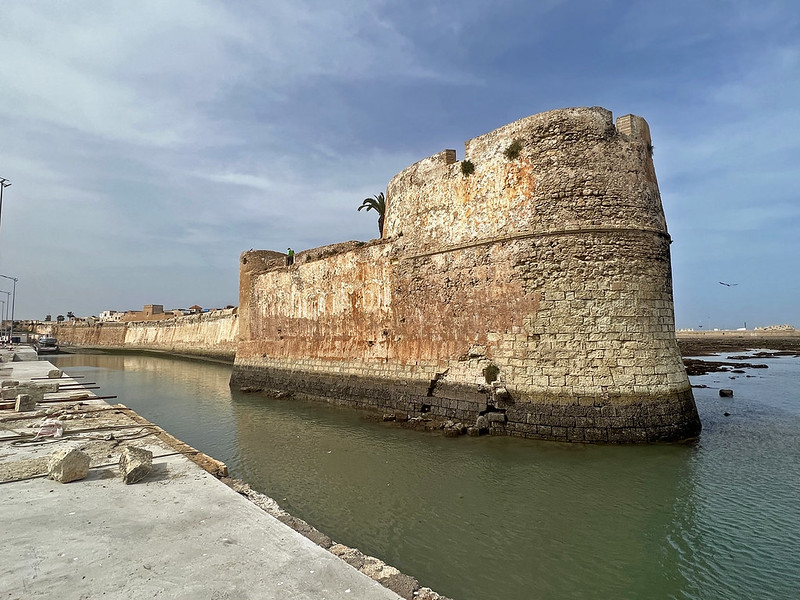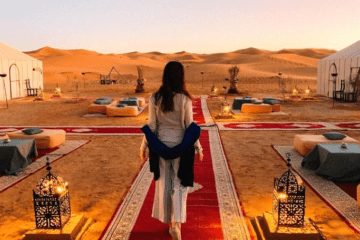In November 2022, UNESCO’s World Heritage Convention will celebrate 50 years! What better way to celebrate than to discover the 9 UNESCO World Heritage Sites in Morocco?
UNESCO’s (United Nations Educational, Scientific, and Cultural Organization) goal is to encourage member nations to identify, celebrate, and preserve their cultural identity so it may be shared with the world.
Scributors shares the list of the 9 UNESCO World Heritage Sites in Morocco; we have listed them in the same order that they were inscribed on the register.
1: The old Medina of Fes, 1981

It comes as no surprise to Scributors that the medina of Fes was the first of Morocco’s UNESCO World Heritage Sites to be included, and after seeing the medina, you’ll understand why.
The Idrissid Dynasty constructed Fes in 789, and under Idriss II’s rule, it eventually became the capital of Morocco. While Fes is no longer the capital, it does claim the title of Morocco’s longest-running imperial city. Morocco’s numerous rulers, such as the Almoravides and notably, the Almohads, have left their mark on Fes.
The medina of Fes is a “living museum,” where life continues largely as it has for centuries. You can see how traditional communities were developed as you travel through the almost unlimited number of small lanes, and how the various sorts of craftspeople each have their own portion dedicated to their profession. Fes has long been considered as Morocco’s spiritual capital, as seen by the many Islamic schools (madrassas or medersas), shrines, innumerable mosques, and Sufi brotherhoods.
If you visit the medina of Fes, you will not be surprised to find that it is the world’s biggest pedestrian-only district! Wear comfortable walking shoes and prepare to spend a whole day seeing the historical, cultural, and religious landmarks of Fes’ medina!
2: Medina of Marrakech, 1985

While Marrakech has become well-known for its nightlife and as a playground for worldwide superstars, the medina of Marrakech remains a powerful reminder of the Almohad Dynasty.
Marrakech was founded in the 11th century by the Almoravides Dynasty but became Morocco’s capital in the 12th century by the Almohads. It was strategically located at the intersection of the Sahara Desert and the Atlas Mountains.
There are numerous historical sites to visit in Marrakech’s medina, including the newly restored Ben Youssef Madrassa, the beautiful Bahia Palace, where you can imagine the opulent life led there by successive viziers, and the Koutoubia Mosque, which inspired other minarets throughout Morocco and Spain.
Also read: Best 20 Things To Do In Marrakech
3: The Kasbah of Ait Ben Haddou, 1987

The ksar of Ait Ben Haddou is located on the Road of 1,000 Kasbahs, which connects Marrakech to the enormous Sahara Desert.
A “ksar” is a North African name for a “fortified village,” and the Ksar of Ait Ben Haddou in southern Morocco is a notable example of Berber construction. The buildings of Ait Ben Haddou are clustered behind a rampart, several of which are connected to one another. It was built with adobe, clay, rammed earth, and wood. While these natural materials are incredibly useful in this location, they also need a lot of upkeep. A local committee is responsible for overseeing the ongoing genuine preservation of the ksar of Ait Ben Haddou as part of its position as a listed UNESCO World Heritage Site in Morocco.
The beautiful walled town of Ait Ben Haddou is still inhabited today, and it has been utilized as a scene in numerous films and TV series due to its distinctive architecture and attractiveness.
Also read: Ait Benhaddou Kasbah, how to get there?
4: Historic City of Meknes, 1987

Meknes is situated in the Saiss Plain, between the Middle Atlas Mountains and the Rif Mountains. Meknes was named after a prominent Berber tribe, the Miknassa, who lived in the area about the 8th century.
Meknes benefited from the succession of Moroccan kingdoms, but it wasn’t until the reign of the Alaouite sultan, Moulay Ismail Ibn Sharif, that Meknes really thrived. Moulay Ismail, having previously controlled Meknes, and with political opponents in Fes and Marrakech, designated Meknes as Morocco’s new capital. Moulay Ismail is claimed to have sought to turn Meknes into Morocco’s Versailles, and he achieved it using some controversial and very brutal means.
While Meknes’ medina is considerably smaller than that of Fes, it has some of the same beauty and historical importance, such as the Bou Inania Madrasa (also titled similarly to that of Fes). Meknes’ cultural features outside of the medina include the granaries, stables, and Agdal reservoir, as well as the recently renovated Mausoleum of Moulay Ismail.
5: The Medina of Tetouan, 1997

Tetouan may be one of Morocco’s lesser-known UNESCO World Heritage Sites. It is a city in northern Morocco, nestled between the Mediterranean Sea and the Jbel Dersa mountain range.
The Phoenicians, Romans, and subsequently the Berber Merenid Dynasty all had an impact on Tetouan’s medina. Tetouan, on the other hand, flourished significantly following the Reconquista (Iberian Crusades), when Muslims and Jews were exiled from Spain and moved here. This effect remained when Tetouan eventually became the capital of the Spanish Protectorate of Spain; in fact, many street signs in the medina are still printed in Spanish, and Spanish is most commonly the second language of locals in many other regions of Morocco, rather than French.
Tetouan’s medina is magnificent, with white-washed walls that earned it the nickname “White Dove” in Morocco. Tetouan’s medina, despite its modest size, retains much of its authenticity and unique beauty.
6: The Roman Ruins of Volubilis, 1997

Volubilis is situated at the foot of Mount Zerhoun, near the Saiss Plain.
The region around the archeological site of Volubilis has a long and rich history, believed to have been inhabited as long ago as 5,000 years ago during the New Stone Age. It was the capital of the Mauretania Kingdom at the time, which spanned North Africa from present-day Algeria to the Atlantic Coast and as far south as the Atlas Mountains. Following its capture by the Carthaginians, it developed into a Roman garrison and started to grow as early as the first century AD.
Later, Arabs arrived, and the region became known as Oualili, said to be derived from the Amazigh term for oleander, a local natural plant. Finally, under the founder of the Idrissid Dynasty, Moulay Idriss 1, Volubilis became the capital, although temporarily.
Volubilis thrived under Roman authority, and the archeological site of Volubilis has some remarkable examples of Roman city planning, architecture, and mosaics.
7: Essaouira Medina, 2001

Essaouira is situated on Morocco’s Atlantic Coast and was known as Mogador until the 1960s. There are two possible theories for the name’s origin: it may allude to a Muslim saint who was buried here in the Middle Ages, or it may derive from the Phoenician term for “small fortress.”
The prosperity of Essaouira may be attributed to its advantageous position as a port on sailing routes connecting Northern Africa, Europe, and Sub-Saharan Africa. Carthaginians lived in Essaouira, just like they did in Volubilis, and it provided a sizable supply of raw materials for purple dye for Roman senators. Later, the Portuguese took control of the area and fought a number of other countries in an effort to overthrow them before Morocco eventually reclaimed Essaouira under Alaouite rule. The Sultan urged Moroccan Jews to migrate here from other locations in order to increase business and compete with the rival port of Agadir.
Even today, the architecture and civil engineering of Essaouira’s medina show a significant European influence. The ramparts are well-kept and provide a lovely view of the ocean. The port is still operational today and is famous for its signature blue fishing boats.
8: El Jadida, the Portuguese city, 2004

El Jadida is a significant port on Morocco’s Atlantic Coast, located around 60 miles (100 kilometers) south of Casablanca.
El Jadida is best known as a walled city established during Portuguese occupation in the early 16th century, according to its listing as one of nine UNESCO World Heritage Sites in Morocco. As the Moroccan Saadian Dynasty strove to reclaim territory and evict foreign powers, Portugal strengthened the city walls to keep El Jadida under its control until the latter part of the 18th century.
Formerly known as “Mazagan,” this name is often credited to the Berbers as its original name, and sometimes to a similar name given by the Portuguese. When Morocco regained Mazagan and was able to repair it after the Portuguese wrecked portions of it before departing the port, the name was changed to “El Jadida” (“The New One”).
The walls have been well maintained, and the Portuguese influence may be seen in the architecture, the absence of a true medina, the famed subterranean cistern, and the cathedral.
9: The Capital city, Rabat, 2012

Rabat, on Morocco’s Atlantic Coast, has served as the country’s political capital since its independence from France in 1965.
The ancient site of Chellah demonstrates that the Phoenicians, the Kingdom of Mauretania, and finally the Romans constructed the area surrounding Rabat, as they did with several other UNESCO World Heritage Sites in Morocco. However, it was under Almohad authority that Rabat began to take form, with the Udayas Kasbah and the Hassan Tour. Later, under the Merenid Dynasty, Chellah was enlarged to serve as a necropolis for the royal rulers’ elite.
Rabat became a sanctuary for pirates due to its closeness to Europe and the resettlement of evicted Muslims from Spain. Finally, under the Treaty of Fez, the French acquired control of Morocco and relocated the Moroccan capital from Fes to Rabat in 1912, where it has stayed ever since. The French influence is seen in Rabat’s “New Town,” with broad streets and government buildings with European-style façades.
Also read: Best Things To Do In Rabat
Conclusion
Overall, Morocco’s UNESCO World Heritage Sites are a tremendous asset to the nation. They exemplify the finest of Moroccan culture and tradition, and they are vital to the country’s economy and society.
Morocco’s UNESCO World Heritage Sites are a must-see for every tourist to the nation. They provide a one-of-a-kind and remarkable experience that will linger long after you depart.









